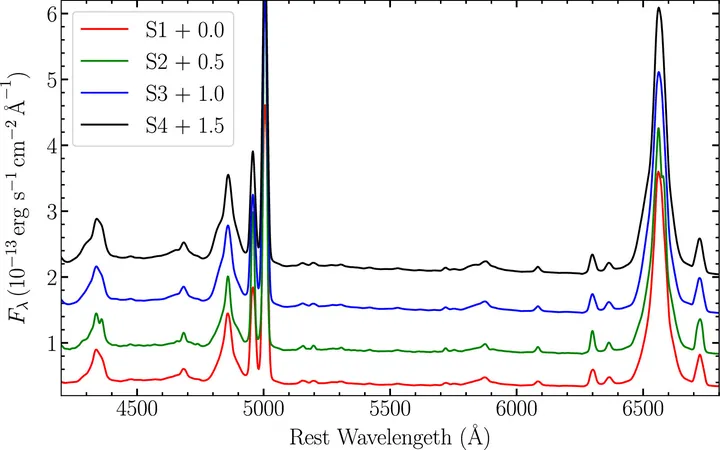
Shocking Discovery: Changes in the Broad-Line Region of Active Galactic Nuclei!
2024-12-27
Author: Yu
Introduction
In an exciting breakthrough in astro-physics, Dr. Feng Haicheng, together with his team from the Yunnan Observatories of the Chinese Academy of Sciences, has unveiled remarkable advancements in understanding the geometry and kinematics of the broad-line region (BLR) in active galactic nuclei (AGN). This innovative research captures the essence of cosmic phenomena and was recently detailed in The Astrophysical Journal.
What are Active Galactic Nuclei?
AGNs, which stand among the brightest entities in our universe, are fueled by the incessant accretion of matter into supermassive black holes (SMBHs) residing at their cores. The BLR, a critical area situated near these SMBHs, is a hub of high-velocity ionized gas that plays a pivotal role in the generation of broad emission lines across ultraviolet and optical spectra associated with AGNs.
Understanding the Broad-Line Region
These emission lines display astonishing widths that can exceed 1,000 kilometers per second. They are primarily produced through photoionization powered by radiation from the accretion disk. Understanding the BLR's geometry and kinematics is instrumental not only for unraveling the physical processes operating within AGNs but also for accurately determining the masses of their central black holes.
Theoretical Models and Observational Challenges
Theoretical models suggest that the gas within the BLR may exhibit a variety of motions, including virialized states or inflow effects driven by the gravitational pull of SMBHs. Additionally, outflows driven by radiation pressure could be more prevalent in high-accretion-rate AGNs. However, the observational evidence surrounding these dynamics has been a mixed bag, potentially due to variations in ionization properties across different AGNs.
Research Methodology
To dive deeper into this mystery, the research team implemented a unique approach: they studied a single AGN under varying brightness states to counteract uncertainties stemming from differences across multiple sources. Their target was the well-known "changing-look" AGN NGC 4151, and they have been conducting an extensive four-year reverberation mapping (RM) campaign utilizing the 2.4-meter telescope at Lijiang Observatory since 2020.
Findings from NGC 4151
Their captivating results unveiled a clear stratification within the BLR of NGC 4151, with various emission lines emerging from specific radial zones within the gas region.
The Anti-Breathing Effect
What’s more intriguing is the discovery of what the researchers termed the "anti-breathing effect." Traditionally, when AGN luminosity increases, the BLR radius is expected to expand — a phenomenon known as the “breathing effect,” which results in longer time delays for broad emission lines. Surprisingly, the data indicated that as the AGN's luminosity heightened, the time delays for these emission lines actually decreased. This unexpected behavior could be linked to discrepancies in time delays between variations in the ultraviolet and optical continuum of the AGN.
Implications of the Research
Through meticulous analysis of velocity-resolved time delays, the team identified significant transformations in both the geometry and kinematics of NGC 4151's BLR occurring on timescales under a year. Such rapid alterations offer a tantalizing glimpse into the underlying complexities of BLR dynamics, suggesting that their physical properties are influenced by an intricate interplay of various mechanisms, rather than being driven by any single element such as gas distribution modifications or shifts in radiation pressure or ionizing fields.
Future Directions
As astrophysicists delve further into the cosmos, this research could pave the way for future studies aimed at unlocking even more secrets hidden within the powerful forces driving active galactic nuclei. Keep your telescope focused on the skies, as more astonishing cosmic revelations await!
 Brasil (PT)
Brasil (PT)
 Canada (EN)
Canada (EN)
 Chile (ES)
Chile (ES)
 Česko (CS)
Česko (CS)
 대한민국 (KO)
대한민국 (KO)
 España (ES)
España (ES)
 France (FR)
France (FR)
 Hong Kong (EN)
Hong Kong (EN)
 Italia (IT)
Italia (IT)
 日本 (JA)
日本 (JA)
 Magyarország (HU)
Magyarország (HU)
 Norge (NO)
Norge (NO)
 Polska (PL)
Polska (PL)
 Schweiz (DE)
Schweiz (DE)
 Singapore (EN)
Singapore (EN)
 Sverige (SV)
Sverige (SV)
 Suomi (FI)
Suomi (FI)
 Türkiye (TR)
Türkiye (TR)
 الإمارات العربية المتحدة (AR)
الإمارات العربية المتحدة (AR)